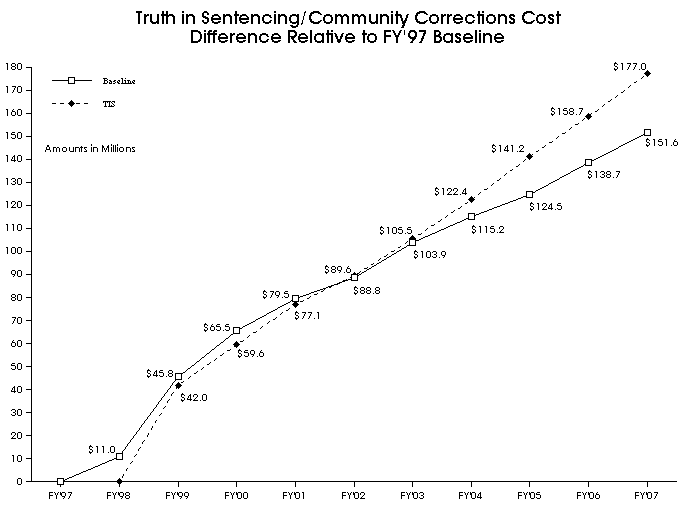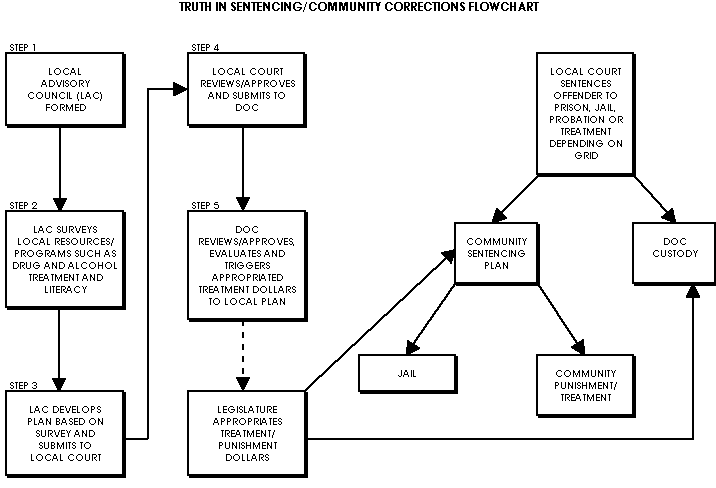Share
back to issue papers


COMPREHENSIVE CRIMINAL JUSTICE REFORM EFFORT
The Speaker and Senate Pro Tempore created the Criminal Justice Reform Group to develop a balanced and comprehensive approach to the criminal justice crisis.
The working group was asked to develop the specifics of a plan that could be supported by the House, Senate, and ultimately, the Governor. Certain parameters were established and specific components had to be addressed:
- A community corrections component (Component I);
- An affordable truth-in-sentencing plan that fits the existing population projections (Component II);
- An appropriation for immediate needs, as well as the annualized costs, for up to 1,500 beds in private prisons; an appropriation to fund bed spaces for at least an additional 800 medium security beds, not to exceed a total of 1,500 beds in public prisons (Component III);
- An RFP process for any additional private and public prison beds (Component IV);
- A statutory method of dealing with overcrowding (Component V).
Current Situation:
Community Corrections Solutions:
- No statewide system of effective community incarceration or punishments;
- Space for the most violent offenders within DOC limited due to the absence of community corrections;
- Limited methods available in many counties to punish non-violent offenders within the community;
- No available community sanction for punishment of non-violent offenders not complying with probation;
- No assessment done on non-violent offenders prior to sentencing;
- Lack of funding for local jails and community programs.
- Truthful and certain punishments for non-violent offenders in the community;
- Development of community corrections plans designed by local law enforcement, court and other governmental officials to meet the needs and resources of various regions of the state;
- Provide an array of punishments and treatment programs such as jail time, restitution, drug and alcohol treatment and literacy programs to community offenders. Community programs would also include jail time sanctions for offenders not complying with the programs to which they are sentenced;
- Provide better information to the sentencing judge by requiring assessment of offenders prior to sentencing;
- Provide adequate state funding for community punishments including reimbursement of jail time for up to one year for certain offenses.
Component II: Truth In Sentencing (TIS)
Current Situation:
TIS Solutions:
- No mimimum time served;
- No truth or certainty of sentences;
- Wide variation in sentences from one county to another;
- Violent offenders not serving enough time;
- Jurors do not get full picture of defendant; Prior and subsequent arrests cannot be considered.
- Mandate all violent felons serve a minimum of 85% of the sentence imposed by the court;
- Non-violent offenders will be considered for parole after a minimum of 75% of time served;
- Provide for increases in punishment based on aggravating factors and prior record;
- Establish certainty in sentencing -- offenders, prosecutors, judges and the public will know what a sentence means;
- Increase the average punishment for violent offenders by 54%;
- Double the average punishment served for aggravated rape and drastically increase the average punishment for all other sexual predators;
- Abolish jury sentencing allowing the court to punish based on all information about the defendant including facts that the jury is prohibited from hearing.
Component III: Appropriation for Immediate Bed Needs
Current Situation:
Bed Need Solutions:
- DOC prison population exceeding 100% of capacity;
- Urgent need for additional capacity at the medium security level and up.
- Add 600 medium security beds at existing DOC facilities;
- Funding for up to an additional 1500 medium level private beds;
- Recommendation to study the converting of existing facilities into medium and maximum security prisons or leasing a new facility.
Component IV: Planning and RFP Process for Additional Beds
Current Situation:
Planning and RFP Process Solutions:
- Crisis response to new bed needs -- no planning process;
- State regularly finds itself in poor bargaining position with private prison vendors;
- State has no process to evaluate cost comparisons of private and public prison bed options;
tate has no site selections process for public prisons.
- Creates a planning process to forecast new bed needs;
- Develop RFPs with a enough advance time for preparation of bids so as to encourage competition;
- Set up an evaluation process so that the state can make the best financial deal possible whether for building a public facility, leasing a private facility or a hybrid of the two;
- Set up an effective, unbiased site selection process for public prisons that takes into account local incentives.
Component V: Statutory Method for Dealing with Overcrowding
Current Situation:
Overcrowding Solutions:
- Currently authorized post-release programs are not being utilized due to public safety concerns and potential legal challenges;
- DOC prison capacity exceeding 100%;
- No mechanism in place to deal with emergency situations such as loss of a facility due to a riot;
- DOC overcrowding pressures could be mitigated through release mechanisms that include effective public safety review procedures.
- Repeal the current Special Supervision Program;
- Provide accountability to the public by including the Governor in the decision process in a new "backend" supervision mechanism;
- Public safety balanced with overcrowding solutions by limiting earned credit to 15% of the sentence for all offenders under the Truth in Sentencing program.


 Oklahoma Senate
Oklahoma Senate

